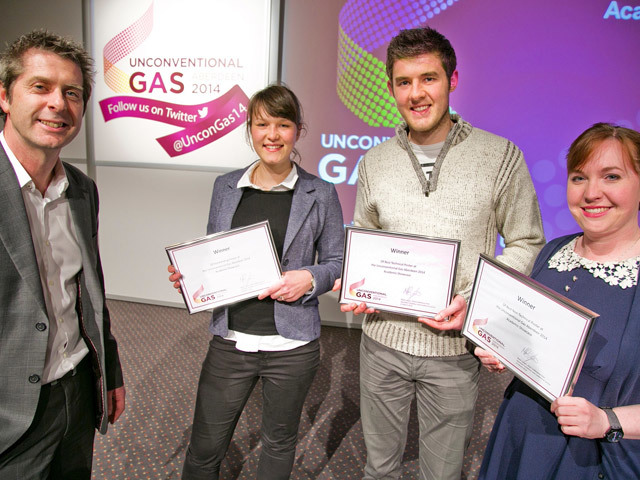
At last month’s highly successful Unconventional Gas Aberdeen – 2014 conference, a new innovation was a competition designed to showcase unconventionals research being conducted at UK universities.
It generated a healthy set of entries from across the UK – both technical and non-technical – with each project presented in the form of a poster.
A team of judges had the invidious task of assessing each presentation before selecting three winners – overall, best technical and best non-technical.
Best non-technical (a £200 prize) went to a team at Plymouth University; while technical (£200) and best overall (£500) went to Manchester teams.
Best overall
Influence of effective pressure on shale matrix permeability: implications for shale gas production: This team, represented by Rosanne Mckernan, is seeking to learn more about the micro-structures of shale formations and the implications for permeability and therefore recovery of potentially viable hydrocarbons.
Despite large amounts of gas in place in many formations, achieving economic flow rates through such low permeability strata is a challenge.
Knowledge of shale mechanical properties and response to stress is required to enhance interpretation of well logs and subsurface variability. This study explores the link between lab-measured mechanical properties and sedimentological, diagenetic and burial histories of shales.
Best non-tech
Underground Britain; public perceptions of the geological subsurface: This team, represented by Hazel Gibson, have learned that, whether it be onshore exploration and extraction of oil and gas, deep injection of water for geothermal power or underground storage of carbon dioxide and radioactive waste, many communities across Europe are being confronted with contested geo-engineering interventions under their backyard.
In order to engage communities and individuals in effective dialogue about geological activities, an appreciation of what “the public” already know and what they want to know is needed, but this is a subject that is in its infancy.
In an attempt to provide insight into these key issues, this study examines the concerns the public have, relating to geology, by constructing “Mental Models” of people’s perceptions of the subsurface.
General recommendations for public engagement strategies will be presented based on the results of selected case studies; specifically expert and non-expert mental models for communities in the south-west of England.
General recommendations for public engagement strategies will, in time, be presented.
Best technical
Diagenetic modifications in the Eagle Ford Formation:
This team, represented by Richard McAllister, has been examining the properties of the legendary Eagle Ford shales in the US.
The Upper Cretaceous Eagle Ford Fmn in southern Texas is a carbonate rich, organic marl currently being targeted for hydrocarbons (gas & oil) and produced through hydraulic fracture stimulation.
This research focuses on a particular unit of the Eagle Ford Fmn known as Facies B. Facies B is predominantly an organic rich formation making it an excellent source rock.
Facies B contains moderate amounts of carbonate (30-50% calcite) making it an ideal self-sourced reservoir which responds well to hydraulic fracturing.
However Facies B also features concretions (packstones and limestones), which can hinder the propagation of fractures. These concretions are laterally variable in outcrop and in core. Some are major beds up to 50cm thick and are continuous throughout outcrops.
The bulk of these beds, however, are much thinner, 10-20cm thick, and are only 1-2m long. These “nodular” concretions are thought to be compositionally the same as the marls but cemented.